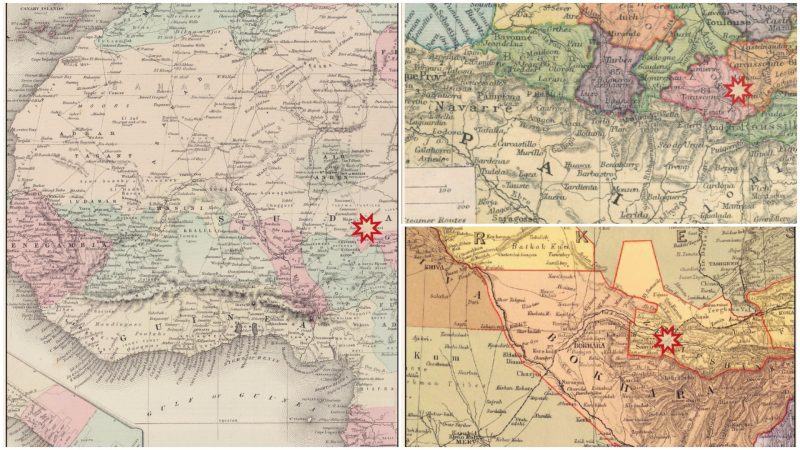Olivier Le Carrer is a journalist and sailor who went to explore and write about some of the most dangerous and doomed places on Earth. His book called “Atlas of Cursed Places: A Travel Guide to Dangerous and Frightful Destinations” represents a collection of detailed maps accompanied by stories about some of the most dangerous and creepy places in the world. here is an abundance of horror, spiritual apparitions, paranormal activity and other mysteries in this beautifully arranged atlas
According to Carrer, there are three types of curses: those of a mystical order, those dealing with the preternatural, and, those of places rendered uninhabitable by human activity. The element that connects all of the curses mentioned is, of course, the bad luck of all of the involved persons.
Here are some of the locations mentioned in the Atlas of Cursed Places.
Oumaradi: The village covered with desert sand
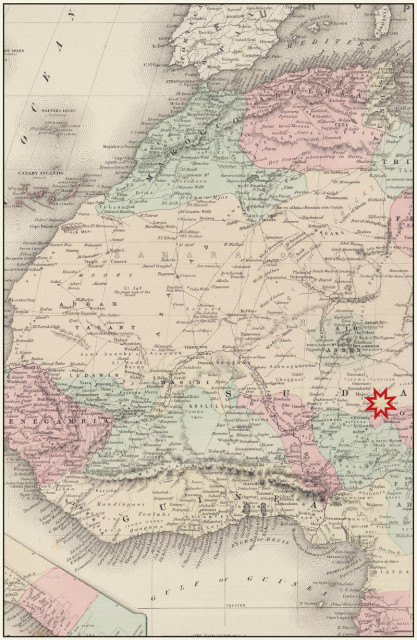
The Harmattan is a dry and dusty northeasterly trade wind which blows from the Sahara Desert over the West African subcontinent into the Gulf of Guinea between the end of November and the middle of March (winter). The name comes from or is related to the Ga language “haramata”. It is cold in some places and hot in others, according to the circumstances. In some countries in West Africa, the heavy amount of dust in the air can severely limit visibility and block the sun for several days, comparable to a heavy. This effect is known as the Harmattan haze. It costs airlines millions of dollars in canceled and diverted flights each year. When the haze is weak, the skies are clear. The dry air can break the trunks of trees growing in the region. This terrible wind is famous among locals as “the doctor”. A strange nickname for something that
The dry air can break the trunks of trees growing in the region. This terrible wind is famous among locals as “the doctor”. A strange nickname for something that doesnt really help people. The desert sand that this wind brings creates huge dunes that can cover entire villages. One such village is Oumaradi in Niger. The winds are so bad here that the village is in danger to be completely covered in sand. It is extremely hard for people to live in Oumaradi.
Poveglia: The Island of Death
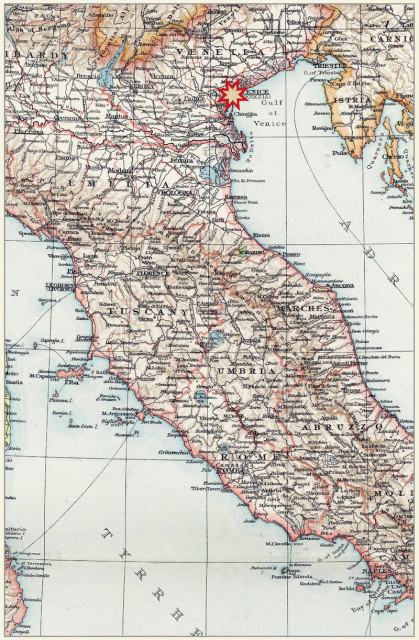
The island of death seems like a suitable name for an island that was once a quarantine zone for lepers plague victims. Poveglia is a small island located between Venice and Lido in the Venetian Lagoon, northern Italy. A small canal divides the island into two separate parts. It was used as a confinement station for the first time in 1793 after several cases of the plague appeared on two ships. In the 20th century, the island was again used as a quarantine station. To make the whole island sound more creepy, in 1922, the existing buildings were converted into an asylum for the mentally ill and for long-term care. This went on until 1968 when the hospital was closed, and the island, after being shortly used for agriculture, was completely abandoned. It is believed (not exactly confirmed) that around 160,000 bodies are buried on Poveglia. There are many accounts of paranormal sightings around the island and this is probably why everybody stays far from it.
This went on until 1968 when the hospital was closed, and the island, after being shortly used for agriculture, was completely abandoned. It is believed (not exactly confirmed) that around 160,000 bodies are buried on Poveglia. There are many accounts of paranormal sightings around the island and this is probably why everybody stays far from it.
Charybdis and Scylla: The strait that sent many ships to the bottom
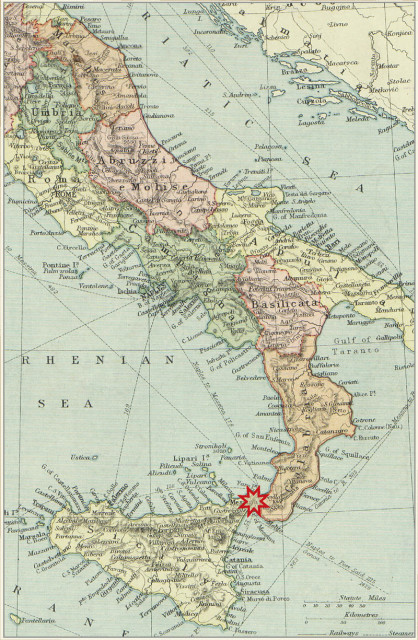
Another cursed location in Italy, this time in the south. Strait of Messina is the narrow passage between the eastern tip of Sicily (Punta del Faro) and the western tip of Calabria (Punta Pezzo) in the south of Italy. It connects the Tyrrhenian Sea to the north with the Ionian Sea to the south, within the central Mediterranean. At its narrowest point, it measures 3.1 km (1.9 mi) in width, though near the town of Messina the width is some 5.1 km (3.2 mi) and the maximum depth is 250 m (830 ft). The strait is characterized by strong tidal currents. A natural whirlpool in the northern portion of the strait has been linked to the Greek legend of Scylla and Charybdis. Scylla made her first appearance in Homer’s Odyssey, where Odysseus and his crew encounter her and Charybdis on their travels. Later myth gave her an origin story as a beautiful nymph who gets turned into a monster. Opposite her was Charybdis, the daughter of Poseidon and Gaia and living as a loyal servant to Poseidon. Zeus, angry for the land she stole from him, cursed her into a hideous bladder of a monster, with flippers for arms and legs, and an uncontrollable thirst for the sea. As such, she drank the water from the sea three times a day to quench it, which created whirlpools. She lingered on a rock with Scylla facing her directly on another rock, making a
Opposite her was Charybdis, the daughter of Poseidon and Gaia and living as a loyal servant to Poseidon. Zeus, angry for the land she stole from him, cursed her into a hideous bladder of a monster, with flippers for arms and legs, and an uncontrollable thirst for the sea. As such, she drank the water from the sea three times a day to quench it, which created whirlpools. She lingered on a rock with Scylla facing her directly on another rock, making a strait. Today, traveling through the strait is relatively safe, but old mariners were terrified of the place. This is probably why the idiom “between Scylla and Charybdis” was coined. It means “having to choose between two evils”.
Gur-Emir: The Mausoleum of an evil conqueror
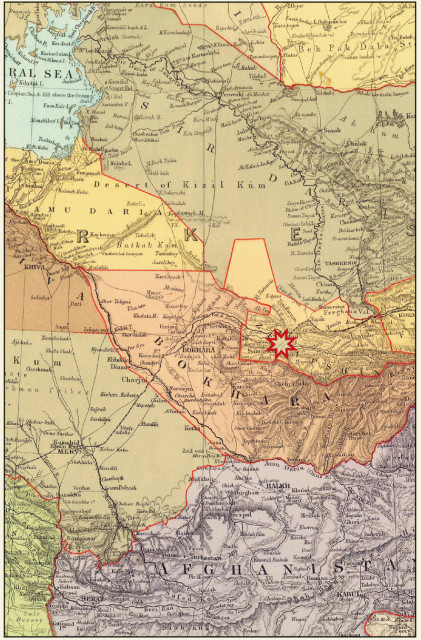
The next location deemed as cursed is in modern day Uzbekistan in a region formerly known as Transoxiana. Timur, historically known as Tamerlane, was a Turco-Mongol conqueror and the founder of the Timurid Empire in Persia and Central Asia. He was also the first ruler of the Timurid dynasty. He ruled in the 14th century. Probably the most infamous thing he did was the slaying of all “useless” people in his kingdom. Scholars estimate that his military campaigns caused the deaths of 17 million people, amounting to about 5% of the world population. Apparently, he considered this huge number of people as purposeless citizens. Timur was also the grandfather of the renowned Timurid sultan, astronomer, and mathematician Ulugh Beg, who ruled Central Asia from 1411 to 1449. After Ulugh was killed in battle, Timur commissioned a mausoleum to be built for him. He also planned to be buried in the same mausoleum. The
Apparently, he considered this huge number of people as purposeless citizens. Timur was also the grandfather of the renowned Timurid sultan, astronomer, and mathematician Ulugh Beg, who ruled Central Asia from 1411 to 1449. After Ulugh was killed in battle, Timur commissioned a mausoleum to be built for him. He also planned to be buried in the same mausoleum. The Gur-e-Amir mausoleum maybe looks marvelous and elegant, but you can not forget the fact that it was built for a mass murderer who killed 17 million people. A creepy thing happened at this place on June 22, 1941, when Russian forensic scientists opened the tomb to examine Timur’s remains. Only a few hours later Germany launched an attack on the Soviet Union. This really sounds like a genuine curse.
